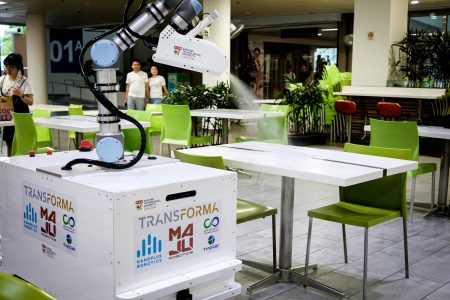By Ian Ransom
One detachment of robots recently became defacto medical staff at a makeshift hospital in Wuhan, China, the epicenter of the COVID-19 pandemic, measuring temperatures, delivering meals, and even entertaining patients. Other robots are being deployed to disinfect hospitals and schools or keep a virtual eye on streets in quarantined cities to urge residents to stay home.
Robots Deliver Drugs and Dancing
Beijing-based robotics company CloudMinds latched onto the potential of its technology early on, sending emergency shipments of robots to hospitals in Wuhan and other Chinese cities. Using an artificial intelligence-enabled information management platform synced to smart bracelets and rings worn by patients, human medical staff were able to monitor patients’ vital signs remotely. Other robots delivered food, drinks, and drugs, while a more social model offered a form of entertainment.
Remote Control Disinfecting Bots Doing the Dirty Work
Technological University (NTU) and affiliated robotics firms hunkered down for six weeks in February and March as the coronavirus spread around the globe to produce a robot that can rapidly disinfect surfaces. Their remote-controlled eXtreme Disinfection roBOT (XDBOT) is equipped with motorized wheels and features a dexterous robotic arm that can largely mimic human movement and reach awkward locations for cleaning, including under tables and beds.
They also believe their robot can not only protect human staff from infection but also solve a labor crunch. Singapore has experienced a sudden shortage of cleaners following the repatriation of many of the city-state’s Malaysian immigrant workers due to the coronavirus.
Protecting Medical Staff
South China-based UBTech Robotics was also quick to react to the coronavirus by re-tooling its robots for medical uses and deploying them at a hospital which treats coronavirus infections in Shenzhen. Apart from equipping one fleet with disinfectant spray-guns, the company fitted other models with thermal cameras that detect fevers in humans and are programmed with algorithms that can determine whether people are wearing protective masks. Their “Cruzr” model of robots are also fitted with two-way video connections that can allow patients to consult remotely based doctors for an initial assessment.
Virus-Tracking Drones Set for Take-Off
The University of South Australia (UniSA) has teamed up with Canadian drone maker Draganfly Inc. to produce drones fitted with sensors and vision systems that can monitor temperature, heart, and respiratory rates, as well as detect people sneezing or coughing in crowds. UniSA’s Professor Javaan Chahl, the project’s lead, says his team’s image-processing algorithms can extract a human’s heart rate at “high accuracy” from drones.
RoboCop on the Beat
Tunisian authorities have taken a novel approach to ensuring law and order. A wheeled robot equipped with video cameras has been on the beat in the streets of the capital Tunis, checking whether local residents are violating lockdown orders that include a ban on going out in public unless to purchase medicine or necessities. Produced by local firm Enova Robotics, the “PGuard” robot approaches pedestrians and asks them to show identification to allow remote police officers to check their details.
Ransom, Ian. “Meet the Robots Working Side-by-Side Essential Healthcare Workers.” Dell Technologies, 18 Aug. 2020.
Analysis–
This article touched on an interesting topic involving the use of robots in healthcare. I think this is an area worth exploring as we see what the needs of healthcare workers are in this climate. The robots deployed in hospitals help with sanitation, entertainment, tracing COVID-19, and much more. It is interesting to see what robots can do and how they can help in healthcare, while keeping the healthcare workers safer. This makes me wonder how robots can be implemented in transit systems to aid passengers if they need help. Thus reducing interactions between passengers and workers. Robots can sanitize subway stations, the interior of buses and other vehicles. There are hard to reach area in vehicles that robots can reach to fully sanitize. I think this article is quite relevant to my topic because it helps me consider the technologies that can be used when designing for the safety of essential workers in the transportation sector.




